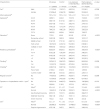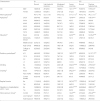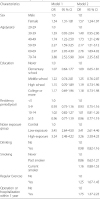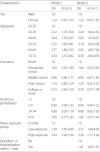1. Kim KS. Hearing Loss. Occupational Disease. 2007. 1. Seoul: Gyechuk Munwhasa.
2. Haralabidis AS, Dimakopoulou K, Vigna-Taglianti F, Giampaolo M, Borgini A, Dudley M-L, et al. Acute effects of night-time noise exposure on blood pressure in populations living near airports. Eur Heart J. 2008; 29:658–64. DOI:
10.1093/eurheartj/ehn013. PMID:
18270210.
3. Willich SN, Wegscheider K, Stallmann M, Keil T. Noise burden and the risk of myocardial infarction. Eur Heart J. 2006; 27:276–82. DOI:
10.1093/eurheartj/ehi658. PMID:
16308324.
4. Hardoy MC, Carta MG, Marci AR, Carbone F, Cadeddu M, Kovess V, et al. Exposure to aircraft noise and risk of psychiatric disorders: the Elmas survey. Soc Psychiatry Psychiatr Epidemiol. 2005; 40:24–6. DOI:
10.1007/s00127-005-0837-x. PMID:
15624071.
6. Chen TJ, Chen SS, Hsieh PY, Chiang HC. Auditory effects of aircraft noise on people living near an airport. Arch Environ Occup Health. 1997; 52(1):45–50. DOI:
10.1080/00039899709603799.
7. Rosenlund M, Berglind N, Pershagen G, Järup L, Bluhm G. Increased prevalence of hypertension in a population exposed to aircraft noise. Occup Environ Med. 2001; 58:769–73. DOI:
10.1136/oem.58.12.769. PMID:
11706142.
8. Tarnopolsky A, Watkins G, Hand DJ. Aircraft noise and mental health: I. Prevalence of individual symptoms. Psychol Med. 1980; 10:683–98. DOI:
10.1017/S0033291700054982. PMID:
7208727.
9. Kim SJ, Chai SK, Lee KW, Park J-B, Min K-B, Kil HG, et al. Exposure–response relationship between aircraft noise and sleep quality: A community-based cross-sectional study. Osong Public Health Res Perspect. 2014; 5:108–14. DOI:
10.1016/j.phrp.2014.03.004. PMID:
24955321.
11. Grandner MA, Jackson NJ, Pak VM, Gehrman PR. Sleep disturbance is associated with cardiovascular and metabolic disorders. J Sleep Res. 2012; 21:427–33. DOI:
10.1111/j.1365-2869.2011.00990.x. PMID:
22151079.
12. Vgontzas AN, Liao D, Pejovic S, Calhoun S, Karataraki M, Basta M, et al. Insomnia with short sleep duration and mortality: the Penn State cohort. Sleep. 2010; 33:1159–64. PMID:
20857861.
13. Phillips B, Mannino DM. Do insomnia complaints cause hypertension or cardiovascular disease. J Clin Sleep Med. 2007; 3:489–94. PMID:
17803012.
14. Mallon L, Broman J-E, Hetta J. Relationship between insomnia, depression, and mortality: a 12-year follow-up of older adults in the community. Int Psychogeriatr. 2000; 12:295–306. DOI:
10.1017/S1041610200006414. PMID:
11081951.
16. Michaud DS, Fidell S, Pearsons K, Campbell KC, Keith SE. Review of field studies of aircraft noise-induced sleep disturbance. Acoust Soc Am. 2007; 121:32–41. DOI:
10.1121/1.2400613.
17. Perron S, Tétreault L-F, King N, Plante C, Smargiassi A. Review of the effect of aircraft noise on sleep disturbance in adults. Noise Health. 2012; 14:58–67. DOI:
10.4103/1463-1741.95133. PMID:
22517305.
18. Franssen EAM, Wiechen CMAG, Nagelkerke NJD, Lebret E. Aircraft noise around a large international airport and its impact on general health and medication use. Occup Environ Med. 2004; 61:405–13. DOI:
10.1136/oem.2002.005488. PMID:
15090660.
19. Floud S, Vigna-Taglianti F, Hansell A, Blangiardo M, Houthuijs D, Breugelmans O, et al. Medication use in relation to noise from aircraft and road traffic in six European countries: results of the HYENA study. Occup Environ Med. 2011; 68:518–24. DOI:
10.1136/oem.2010.058586. PMID:
21084328.
20. Seoul Regional Aviation Administration. The official announcement of Seoul Regional Aviation Administration (No. 2010-53), The alteration of the areas affected by aircraft noise in Gimpo International Airport. 2010.
http://www.moi.go.kr/frt/sub/a05/gwanboMain/screen.do. Accessed 23 Dec 2014.
21. Lim C, Kim J, Hong J, Lee S, Lee S. The relationship between civil aircraft noise and community annoyance in Korea. J Sound Vib. 2007; 299:575–86. DOI:
10.1016/j.jsv.2006.06.064.
22. Lim C, Kim J, Hong J, Lee S. Effect of background noise levels on community annoyance from aircraft noise. Acoust Soc Am. 2008; 123:766–71. DOI:
10.1121/1.2821985.
23. Bastien CH, Vallieres A, Morin CM. Validation of the Insomnia Severity Index as an outcome measure for insomnia research. Sleep Med. 2001; 2:297–307. DOI:
10.1016/S1389-9457(00)00065-4. PMID:
11438246.
24. Ensrud KE, Joffe H, Guthrie KA, Larson JC, Reed SD, Newton KM, et al. Effect of escitalopram on insomnia symptoms and subjective sleep quality in healthy menopausal women with hot flashes: a randomized controlled trial. Menopause. 2012; 19:848. DOI:
10.1097/gme.0b013e3182476099. PMID:
22433978.
25. Johns MW. A new method for measuring daytime sleepiness: the Epworth sleepiness scale. Sleep. 1991; 14:540–5. PMID:
1798888.
27. Porter ND, Kershaw AD, Ollerhead JB. Adverse effects of night-time aircraft noise: Civil Aviation Authority in London. 2000.
28. Jakovljević B, Belojević G, Paunović K, Stojanov V. Road traffic noise and sleep disturbances in an urban population: cross-sectional study. Croat Med J. 2006; 47:125–33. PMID:
16489705.
29. Marks A, Griefahn B. Associations between noise sensitivity and sleep, subjectively evaluated sleep quality, annoyance, and performance after exposure to nocturnal traffic noise. Noise Health. 2007; 9:1. DOI:
10.4103/1463-1741.34698. PMID:
17851221.
30. Öhrström E. Longitudinal surveys on effects of changes in road traffic noise—annoyance, activity disturbances, and psycho-social well-being. J Acoust Soc Am. 2004; 115:719–29. DOI:
10.1121/1.1639333. PMID:
15000184.
31. Miedema HM, Vos H. Associations between self-reported sleep disturbance and environmental noise based on reanalyses of pooled data from 24 studies. Behav Sleep Med. 2007; 5:1–20. DOI:
10.1207/s15402010bsm0501_1. PMID:
17313321.
32. Buysse DJ, Reynolds CF, Monk TH, Hoch CC, Yeager AL, Kupfer DJ. Quantification of subjective sleep quality in healthy elderly men and women using the Pittsburgh Sleep Quality Index (PSQI). Sleep. 1991; 14:331–8. PMID:
1947597.
33. Thase ME. Depression and sleep: pathophysiology and treatment. Dialogues Clin Neurosci. 2006; 8:217–26. PMID:
16889107.
34. Katz DA, McHorney CA. The relationship between insomnia and health-related quality of life in patients with chronic illness. J Fam Pract. 2002; 51:229–36. PMID:
11978233.
35. Ford DE, Kamerow DB. Epidemiologic study of sleep disturbances and psychiatric disorders: an opportunity for prevention? JAMA. 1989; 262(11):1479–84. DOI:
10.1001/jama.1989.03430110069030. PMID:
2769898.
36. Eaton WW, Badawi M, Melton B. Prodromes and precursors: Epidemiologic data for primary prevention of disorders with slow onset. Am J Psychiatry. 1995; 152:967–72. DOI:
10.1176/ajp.152.7.967. PMID:
7793466.
39. Buxton OM, Lee CW, L'Hermite-Balériaux M, Turek FW, Van Cauter E. Exercise elicits phase shifts and acute alterations of melatonin that vary with circadian phase. Am J Physiol Regul Integr Comp Physiol. 2003; 284:R714–R24. DOI:
10.1152/ajpregu.00355.2002. PMID:
12571075.
40. Davies C. Thermoregulation during exercise in relation to sex and age. Eur J Appl Physiol Occup Physiol. 1979; 42:71–9. DOI:
10.1007/BF00421907. PMID:
510285.
42. Pirrera S, De Valck E, Cluydts R. Nocturnal road traffic noise: A review on its assessment and consequences on sleep and health. Environ Int. 2010; 36:492–8. DOI:
10.1016/j.envint.2010.03.007. PMID:
20406712.









 PDF
PDF Citation
Citation Print
Print



 XML Download
XML Download